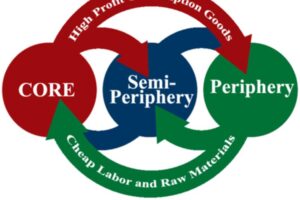
Q2. (a) Examine the recent views on mountain building process and divide the world mountains on the basis of their genesis . 20 Marks (PYQ/2024)
Geomorphology / Plate Tectonic Theory / Mountain Building
Answer:
Introduction
Mountain building (or orogenesis) refers to the geological processes responsible for the formation of mountain ranges, typically through tectonic forces such as plate convergence, folding, faulting, and volcanism. While earlier explanations focused on vertical movements (e.g., geosynclinal theory), recent views emphasize plate tectonics, mantle dynamics, and isostatic adjustments.

Recent Views on Mountain Building
1. Plate Tectonics Theory (1960s onwards)

- Proposed by McKenzie and Parker, it revolutionized the understanding of orogenesis.
- Convergent plate boundaries (continental-continental or oceanic-continental) lead to fold mountain formation.
- Subduction zones, accretionary prisms, and collision zones are central to mountain formation.
Example: The Himalayas formed due to the collision of the Indian and Eurasian plates.
2. Mantle Plume Theory

- Proposed by W. Jason Morgan, explains intraplate mountains due to hotspots and thermal upwelling of magma from deep mantle.
- Leads to volcanic mountains.
Example: Hawaiian Islands.
3. Isostasy and Orogenic Uplift

- Based on Airy-Heiskanen and Pratt’s models, mountain mass maintains gravitational equilibrium.
- Post-erosional isostatic rebound contributes to secondary uplift in mountain regions.
4. Continental Accretion and Terrane Theory

- Fragments of crust (terranes) attach to continental margins during subduction.
- Important in the formation of complex mountain systems like the Rockies and Andes.
Classification of Mountains Based on Genesis
| Type of Mountain | Process Involved | Examples |
| Fold Mountains | Crustal compression and folding | Himalayas, Alps, Rockies, Andes |
| Block Mountains | Faulting and vertical displacement | Vosges (France), Sierra Nevada (USA), Satpura (India) |
| Volcanic Mountains | Accumulation of lava and pyroclastic flows | Mt. Fuji, Mt. Kilimanjaro, Mauna Loa |
| Residual Mountains | Erosion of surrounding areas | Aravallis (India), Ural Mountains |
| Dome Mountains | Magma uplift without eruption | Black Hills (USA), Adirondacks (USA) |
Models and Theories Involved
- Geosynclinal Theory (Kober, Suess): Outdated model involving geosyncline subsidence and orogenic uplift.
- Plate Tectonics (McKenzie, Wilson): Dominant model explaining mountain formation through lithospheric plate interactions.
- Thermal Convection Theory (Holmes): Supports mantle dynamics in crustal deformation.
- Quantitative Revolution: Enabled use of remote sensing, GIS, and tectonic geomorphology to model orogenesis.
Case Study 1: Himalayan Orogeny
- Ongoing orogenesis due to convergence of Indian and Eurasian plates.
- Continental collision caused intense folding, thrusting, and seismic activity.
- Supports Continental Drift (Wegener) and Plate Tectonic Theory.
- Evidence: GPS measurements show northward drift of Indian plate at ~5 cm/year.
Case Study 2: Andes Mountain Formation
- Formed along oceanic-continental convergent boundary.
- Nazca Plate subducting under South American Plate causes folding, volcanism, and earthquakes.
- Accompanied by Andean-type orogenesis with both fold and volcanic mountains.
Conclusion
Modern understanding of mountain building emphasizes dynamic Earth processes, particularly plate tectonics, mantle convection, and isostatic adjustments. Mountains are no longer viewed as static features but as evolving landforms influenced by endogenic and exogenic forces. The classification based on genesis helps explain spatial variation in mountain types and supports effective regional planning, disaster management, and environmental conservation in mountainous areas.


